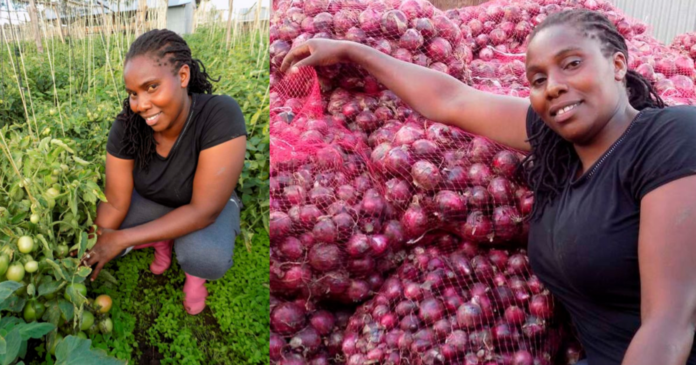At the onset of the COVID-19 pandemic in 2020, the government of Kenya shut down schools temporarily.
This occurrence marked a significant turning point in the life of Margaret Njenga, a 36-year-old woman.
She decided to leave her job and pursue an opportunity in the farming industry that she believed had the potential to generate significant profits.
The alumnus of St. Johns Teachers Training College in Kilimambogo retired to her farm in Kiserian, where she practices mixed farming.
“I taught for about four years. Then Covid-19 happened in March 2020. When schools were shut, I moved to Kiserian, my parent’s home and started to farm. I quit teaching to concentrate on farming after realising it’s well paying,” Margaret recalls.
But even before leaving her teaching job, Margaret practised telephone farming. Margaret has 4 acres of land where she’s planted onions, cabbages, spinach, collard greens, tomatoes, capsicums and beetroots.
She is also a poultry and livestock farmer; keeping cows, goats, chickens, rabbits and ornamental birds.
Margaret has a particular fondness for onions. She says they provide a high return on investment. She has allocated 1 acre of her farmland for onion farming which she cultivates using irrigation techniques.
The remaining crops sit on smaller plots of approximately a quarter acre each.
“I started farming onions on half-acre, investing Sh. 200,000 capital, money that went on installing drip lines, preparing the farm and buying seeds,” Margaret explained.
Magaret eventually expanded her farming operation by an additional half-acre. She invested Sh. 270,000 in installing more drip irrigation lines to increase her yield.
While farming, Margaret notes that seeds are one of her highest expenses. She buys seeds at Sh. 30,000 per kilogram.
Onions require a total of 135 days to mature, with 45 days spent in the nursery and the remaining 90 days on the farm.
As per Margaret, she harvests 15 tonnes of onions, a significant increase from the 8 tonnes she used to produce when she was a part-time farmer.
READ: Mary Githinji: How I made Sh. 1.5 million from my first bulb onions harvest
Margaret sells her onions at Sh. 70 per kilogram. This is a considerable improvement from the Sh. 30 per kilogram for which she once sold her onions.
“For onions, the worst thing you can do is to grow them in a small portion. It is better to invest Sh. 200,000 and farm on an acre, two or three. The higher the tonnage, the higher the income.”
The outcome of one’s harvest is heavily influenced by how crops are managed.
“When you get 15 tonnes every four to five months, that comes to over Sh. 1 million, and you can have three seasons in a year,” Margaret explains.
Additionally, Margaret incorporates crop rotation in her farming practices by growing onions alongside tomatoes or cabbages. The respective pairs have a growth cycle of 3 months.
“The advantage of mixed farming is that you can’t fail to get some money. Onions take some four months to mature. As I’m waiting, I sell cabbages and tomatoes, thus get income throughout the year like a salaried person,” she adds.
To nurture her crops, she uses manure derived from her own livestock, as well as, purchasing additional manure from neighbouring farms.
Margaret emphasizes the importance of soil testing in determining which fertilizers to use, as it led her to abstain from utilizing Diammonium Phosphate (DAP).
“I can’t use DAP according to the soil analysis report. I plant with manure, and after two weeks, I apply CAN. After 4 weeks, I apply NPK,” she states.
Furthermore, Margaret keeps the Kenbro and Kienyeji chicken varieties for meat and eggs. She sells Kienyeji cockerels at Sh. 1500, hens at Sh. 800 and an egg for Sh. 20.
Margaret initially kept 3 rabbits in her farm. The numbers grew to eight. She says that she keep rabbits for their beauty. She also explained that she had five cows, all of whom calved down, resulting to a total of 10 cows.
On a daily basis, she is able to extract over 70 liters of milk, which she then sells to a cooperative society located in Kiserian for a price of Sh. 40 per litre.
“In the morning, I supply 40-45 litres. At noon I supply 25 litres, and in the evening I don’t supply,” Margaret noted.
A take-away to young aspiring farmers: “You only need water, determination and hope. Many people ask me why I quit teaching. It is a personal decision. Go for your goals.”








